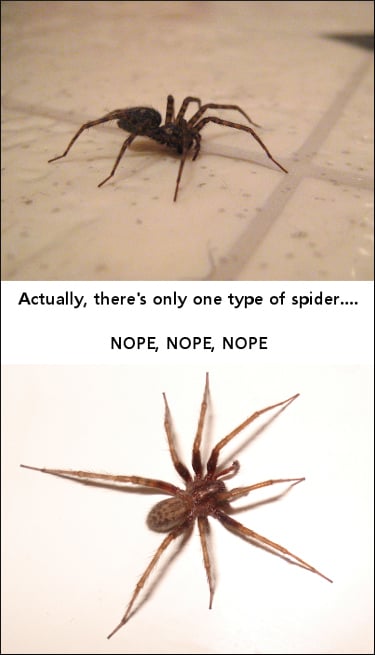After what seemed like a month of perpetual gray, rainy, damp weather, the sun made it’s first appearance in the Southeast. While the temperatures aren’t yet cold enough to drive away the insects, all the additional moisture means the outdoors is teeming bugs (I believe the scientific term is “creepy crawlies”). Fall is here, and winter is rapidly approaching, so most of these insects are looking for somewhere warm to bed down for the winter. Lo and behold, they find it – your house! Before you break out the insecticide, there is one good way to combat fall bugs in your basement or crawlspace – a good dehumidifier. Learn how to get rid of bugs with a basement dehumidifier below.
 By now, we’re familiar with using a dehumidifier during the spring and summer months. Those typically tend to be the wetter parts of the year and times when humidity can make conditions ideal for spiders, ants, cockroaches, and spiders. I mention spiders twice because there are effectively two varieties, spiders and HOLY CRAP!. Dehumidifiers remove excess moisture from the air, and dry conditions can drive insects out to seek better accommodations. Most insects don’t drink water or anything for that matter. Instead, they absorb moisture through their bodies, so when there’s not enough moisture in the air to keep them alive, they either leave or die. Either way, it’s a win for you.
By now, we’re familiar with using a dehumidifier during the spring and summer months. Those typically tend to be the wetter parts of the year and times when humidity can make conditions ideal for spiders, ants, cockroaches, and spiders. I mention spiders twice because there are effectively two varieties, spiders and HOLY CRAP!. Dehumidifiers remove excess moisture from the air, and dry conditions can drive insects out to seek better accommodations. Most insects don’t drink water or anything for that matter. Instead, they absorb moisture through their bodies, so when there’s not enough moisture in the air to keep them alive, they either leave or die. Either way, it’s a win for you.
During the more humid portions of the year, just about any room in the house can be one where you’ll find people using a dehumidifier. However, during the winter months, dehumidifier use if often in one of two places, your basement or crawlspace. Crawlspaces are the lesser of the two. Since many parts of the country are prone to freezing, a crawlspace dehumidifier is often removed, drained, and stored for the winter months. Once temperatures dip below 40° or so, refrigerant style dehumidifiers become ineffective anyways. So for those with a basement, using a dehumidifier in winter is more common. Basements often stay well above freezing but typically have higher humidity, even when it’s cold out.
A basement dehumidifier can do a couple things. First, it can remove the excess moisture in the space. As basements tend to have more humidity, they are often the space where insects reside. And aside from doorways and windows, basements are often an entry point for insects. So keeping this space dry goes a long  way to reducing insects in your home. More often than not, the cold air return of furnace/HVAC system is located in the living quarters of the home. So the air that is dried in the basement usually stays in the basement. This is important because most people who use any type of forced air heating system during the winter knows these often create conditions in the home that are exceedingly dry. We end up using a humidifier to restore comfort and moisture back to the air. So basically, what you have is moisture in places where you don’t want it (the basement) and a lack of moisture in the place where you do want it (living spaces). A basement dehumidifier won’t contribute to the problem upstairs but CAN help reduce the insect issue in the basement.
way to reducing insects in your home. More often than not, the cold air return of furnace/HVAC system is located in the living quarters of the home. So the air that is dried in the basement usually stays in the basement. This is important because most people who use any type of forced air heating system during the winter knows these often create conditions in the home that are exceedingly dry. We end up using a humidifier to restore comfort and moisture back to the air. So basically, what you have is moisture in places where you don’t want it (the basement) and a lack of moisture in the place where you do want it (living spaces). A basement dehumidifier won’t contribute to the problem upstairs but CAN help reduce the insect issue in the basement.
Dehumidifiers aren’t just for the summer and spring. They can help year round, even while you combat fall insects. If you’re interested in learning more about dehumidifiers, how they work, how to keep bugs out of the basement, and what’s available, visit our in-depth Dehumidifier Buying Guide.
